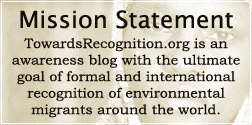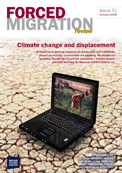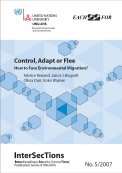(The New Republic) January 4, 2010 – Joanna Kakissis has a nicely reported piece in The New York Times today on climate-driven migration in developing countries. The concept’s pretty simple: As the planet heats up, many regions are expected to see more frequent (and more severe) floods, droughts, and storms, which will uproot a bunch of people, especially in rural areas. So we’re likely to see many more stories like this one:
Mahe Noor left her village in southern Bangladesh after Cyclone Sidr flattened her family’s home and small market in 2007. Jobless and homeless, she and her husband, Nizam Hawladar, moved to this crowded megalopolis, hoping that they might soon return home.
Two years later, they are still here. Ms. Noor, 25, and Mr. Hawladar, 35, work long hours at low-paying jobs—she at a garment factory and he at a roadside tea stall. They are unable to save money after paying for food and rent on their dark shanty in Korail, one of the largest slums in Dhaka. And in their village, more people are leaving because of river erosion and dwindling job opportunities.
“We’re trapped,” Ms. Noor said.
In the past, many analysts argued that climate-driven migration would lead to tens of millions of “climate refugees” pouring into wealthy countries. Droughts in North Africa, say, would push people into Europe. (This explains why some European anti-immigration groups have adopted green rhetoric.) But more recent research suggests that most of the migration will take place within developing countries—from rural areas to cities. And the main worry here is that these cities are already swelling exponentially, and their infrastructure can barely keep up, which is why many “megacities” sport massive slums.
Now, the tricky part is tying these trends to climate change. After all, severe storms and droughts are nothing new. Nor is internal migration. People in developing countries have been flocking to cities for a long time,
whether it’s to seek out work or because the rainfall’s dried up or because the soil’s eroded away. We can say that global warming will exacerbate these pressures and greatly increase the pace of migration, but it’s hard to attribute any single event—or single migrant—to man-made climate change. (Virtually no scientist will say that Cyclone Sidr was caused by global warming, though many will agree that this type of event will become more frequent as the oceans heat up.)
This seems like hairsplitting, but it could become a major issue. One of the few concrete items that came out of Copenhagen was a pledge by rich countries to set up a $100 billion annual climate fund by 2020 (with smaller amounts of climate aid dribbling in earlier). Some of
this money is supposed to help poor countries adapt to a warmer world. But how do you distinguish between people displaced specifically by climate change and those migrating for other reasons? The difficulty in sorting out causes is one reason why forecasts of “climate refugees” vary so wildly, from 200 million by 2050 to one billion by 2050.
So climate-driven migration is a real concern, but it’s worth being precise about the concept. Geoff Dabelko, who directs the Environmental Change and Security Program at the Wilson Center, had a smart post back in 2007 urging environmentalists to be careful when using the term “climate refugee” (the word “refugee” is particularly problematic, since it has a precise legal definition and invokes certain responsibilities by governments). Otherwise, the problem just gets harder to solve.
Source: The New Republic



